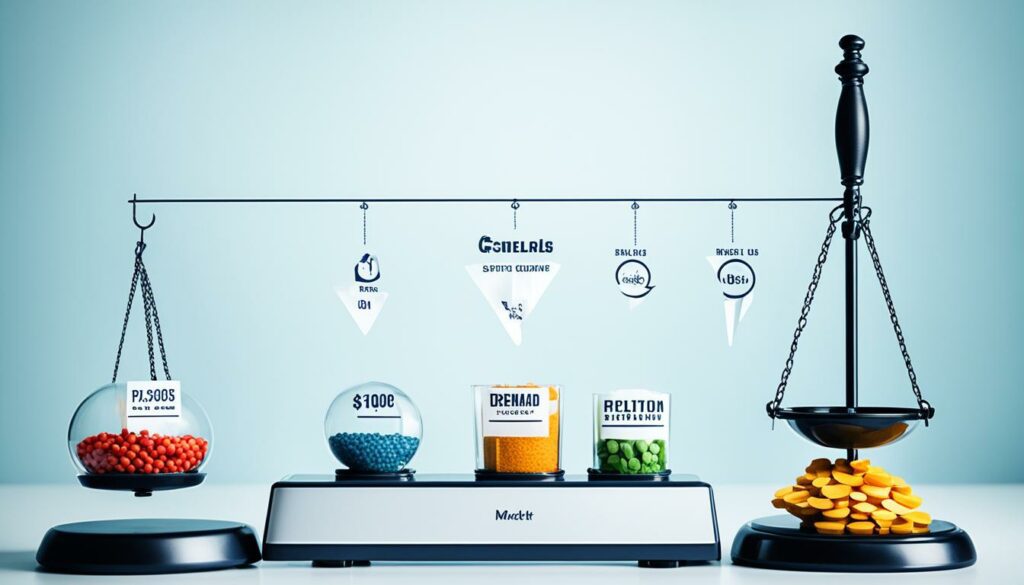Menu

Did you know, a business’s global growth depends a lot on its export pricing strategy? In 2023, having the right pricing is key. It’s about finding the balance between making a profit and being affordable for customers around the world.
With the world becoming more connected, we need to be smart about setting prices. We must look closely at costs, what customers want, currency changes, what rivals are charging, and local rules. Using this approach helps businesses be both competitive and make money in different parts of the world.
When businesses want to grow globally, they need to think carefully about pricing. They must consider things like how they make their products, the needs of each industry, and what customers will pay. This is vital when they’re stepping into new markets, dealing with big stores, or introducing something new.
Setting export prices isn’t just about using one rule. It takes different strategies like adding costs and looking at what others are charging. These strategies depend on where you’re selling, understanding all your costs, and how you get your products to customers, especially in really competitive areas. Companies change their strategies to deal with many challenges such as getting into new markets or handling requests to lower prices.
A good export pricing plan isn’t just about picking any number. It means thinking about many things to keep growing in a world that’s always changing.
Setting the right export prices is crucial for companies wanting success globally. It looks at the costs and current market. Let’s explore how companies decide their prices for the world market.
Export pricing is when companies set prices for products or services in other countries. They carefully consider production costs, freight, marketing, and local market needs. Having the right pricing is key to doing well in global markets.
There are many important points to think about for pricing well globally:
| Consideration | Details | Impact |
|---|---|---|
| Production & Transportation Costs | Includes manufacturing and logistics expenses | Determines base pricing level |
| Market Demand Analysis | Elastic vs. inelastic demand | Influences price optimality |
| Competitor Pricing Analysis | Examines rival pricing models | Sets competitive benchmarks |
| Exchange Rate Volatility | Fluctuations in currency values | Affects final pricing strategy |
| Regulatory Compliance | Adherence to tariffs & antidumping laws | Ensures market entry and continuity |
| Pricing Adjustments | Discount and allowance considerations | Enhances value proposition |
| Market Segmentation & Product-Line Pricing | Tailored strategies by segment & line | Maximises reach and profitability |

Finding the right costs is key to setting export prices. It involves looking at all the costs to get the product to the buyer abroad. These costs include what it takes to make the product and other support costs. Both types are needed to decide on good prices for world markets.
Direct costs are things like what it takes to make the product or buy it if you’re a middleman. These costs are clear and easy to figure out. They include money spent on raw materials, labour, and transport.
Indirect costs are different. They’re not as obvious but they still matter a lot. They include things like admin costs, marketing, and storage. These costs help make and sell products but aren’t part of one specific product’s cost.
It’s very important to carefully look at what you spend on shipping and the taxes involved. For instance, duties and VAT can make products twice as expensive to sell overseas. Keep in mind translation costs and other fees that could also raise your prices.
It’s important to consider all the costs such as:
Due to many expenses, exporters often use Incoterms to manage costs. Choosing the right Incoterm, like CIF, makes responsibilities clear. Deciding between different pricing methods also helps match costs with what the market will pay.
| Cost Component | Percentage of Total Cost |
|---|---|
| Production Costs | 40% |
| Shipping & Logistics | 20% |
| Tariffs & Duties | 15% |
| Insurance & Compliance | 10% |
| Administrative & Marketing | 15% |
This full approach helps set strong prices for selling overseas. It keeps you profitable and ahead of your competition.
Effective export pricing strategies start with thorough market research. It’s vital to understand the economy, how people buy, and what rivals are doing in the target area. This knowledge helps set the best prices, making your firm more competitive worldwide. Careful study of market demand and what your competitors are up to are key parts of the plan.
To truly understand market demand, look at things like income and whether people can buy consumer goods. This gives a glimpse into how much customers might buy from you. When setting prices, remember to include extra costs like research or travel. These add to the final price.
Knowing your competition well is also crucial. It lets U.S. companies tweak their prices to attract more customers. By checking what competitors are charging and sometimes changing your product, you can stay one step ahead. Pricing methods like marginal cost ensure you keep up but still make money.
| Pricing Strategy | Key Considerations | Impact on Pricing |
|---|---|---|
| Cost-Plus Pricing | Administration costs, R&D, overheads, customs fees | Higher final price to cover all additional expenses |
| Marginal Cost Pricing | Direct out-of-pocket costs only | Competitive pricing without incurring a loss |
| Market-Driven Pricing | Market demand and supply, competitor prices | Flexible pricing based on market conditions |
| Competitive Pricing | Analysis of competitors’ prices | Prices set to match or undercut competition |
By mixing these pricing methods with keen market and competitive checks, companies stand a better chance in the global market. They can tweak pricing to attract and keep customers.
In today’s world, getting market-driven pricing right is key for overseas sales. This approach looks at setting product prices based on what’s happening in the market. This includes changes in how much people want, how much is available, and the impact of inflation. Doing this well makes sure your products are priced to compete but still make money.

The heart of market-driven pricing is knowing what the market wants and what’s available. By keeping tabs on these, companies can change their prices to match the current market. For example, more demand might mean you can charge more. Less supply might push you to drop your prices. This helps companies make more money and keep up with what the market needs, leading to better export prices.
Being able to change prices is crucial with market-driven pricing. Exporters need to balance their prices with market changes and their desired profit. Giving deals, like trade discounts, can catch the eye of overseas buyers and boost your standing against the competition. But, it’s important to change prices carefully to avoid any problems and to keep making money.
Using a pricing system that can easily change, and keeping an eye on the market, helps you deal with the ups and downs in international markets. It also lets you focus on getting your prices right for your customers. Every price change should help you keep strong in the market.
Using a skimming pricing strategy lets companies get back their early costs and make the most profit at first. It’s great for new, high-in-demand items in markets that are already strong. This strategy starts with setting the price high. That way, it grabs the interest of those who want to be first and are happy to pay more. As time goes on, the price can come down. This makes the product appeal to a wider group of customers.
For this strategy to work, you need to think about a few things. You have to look at how much people want the product, how much it costs to make, and what your competitors are doing. By aiming at those who are ready to pay more at the start, companies can earn a lot early on. This money can help cover the costs of making and developing the product. But, it’s a balance. Setting the price too high can put off possible buyers. So, keeping an eye on the market and being ready to change the price is important.
Companies must also keep watch on things outside their control, like changes in currency values and the rules in different places. By staying on top of these factors, they can keep their advantage. They can also smoothly move to lower prices over time to grab more of the market.
| Factor | Importance |
|---|---|
| Market Demand | High |
| Production Costs | High |
| Competitor Pricing | Medium |
| Currency Fluctuations | Medium |
| Local Regulations | Low |
Choosing skimming pricing can divide the market at first, attracting people who love new tech and gadgets. Then, as the price falls slowly, more people can buy it. This way, the product can make more money through its life on the market. In the end, this method is a good way for businesses to earn extra right at the start. It also helps keep them strong in the market for the long term.
Penetration pricing is a key strategy for new businesses. It involves setting lower prices than rivals. This helps the company quickly attract many customers. As a result, they gain market share faster.
This strategy is especially great for products sensitive to price changes. When prices drop, people often buy more. This boosts sales and helps balance the early low-price strategy.

Lower prices at the start also help with production costs. Selling more units cuts down the cost per unit. This leads to savings, which is good for the company.
Many new businesses use penetration pricing to stand out. It works well for products in high demand. The low prices grab customer attention and can grow loyalty over time.
But, there are risks to be aware of with this method. Customers may leave when prices go up. Also, some might think low prices mean low quality, hurting the brand.
To avoid these pitfalls, companies must plan price increases carefully. Doing it slowly keeps customers happy. They also need to consider a long-term pricing plan to stay competitive.
Watch out for what competitors might do, too. They might lower their prices in response, starting a price war. This could harm everyone’s profits. So, detailed planning is crucial for success with penetration pricing.
Preemptive pricing is a powerful approach to gain an upper hand in a market. It involves setting prices lower than the cost of making the product. This may scare off competitors, aiming for market control. While risky, it can lead to big wins for a company.
Many UK companies overlook export opportunities despite the country’s strong export scene. In 2021, the UK ranked seventh globally in export value at £636 billion. This leaves a big chance for companies ready to take on bold strategies like preemptive pricing to beat their rivals.
The main downside of preemptive pricing is clear. You sell at very low prices, possibly losing money, to push out rivals. This can hurt your profit in the short run. Look at what happened with Spice Kitchen. They got a grant from the Department for International Trade to attend a Dubai trade show. This step led to new business, showing grants can help offset early pricing losses.
But the upsides are significant. Holding on to this pricing can put you in control of the market. There are also benefits, like collecting Membership Rewards® points with the American Express® Business Card. These can ease the pressure of competing.
Overall, using preemptive pricing and other bold market approaches can change a business’s place in the world market. It encourages growth and enlarges their international footprints with careful steps.
Marginal cost pricing focuses on setting prices using only variable costs. It’s great for competitive export markets. Here, managing costs and offering affordable products are key.

Using marginal cost pricing, it’s vital to look at variable expenses well. This means costs like raw materials, labour, and packaging. Knowing these helps exporters set prices that draw in customers. It also ensures all costs are covered.
Don’t forget to consider other costs, like market research and business trips. These are important for staying competitive at home and abroad.
Marginal cost pricing has good and bad points. The main strength is staying competitive with low prices. This is handy in export markets with high tariffs and fees. Not including fixed costs helps handle these issues.
But, it’s important to balance quick cost decisions with long-term success. Scholars agree this can work, but it needs careful planning. You must watch costs closely to avoid problems.
“Exporters often need to match or underprice competitors to gain market share, especially when facing high additional costs like tariffs and VATs,” Salvador Gil‐Pareja (2002) highlights in his analysis of the European export market.
Getting export pricing right mixes many elements to stand well in the international market. It’s key to know that extra import costs can hike up U.S. prices for buyers overseas. Managing this aspect with smart market positioning strategies makes a product stay competitive worldwide.
In the world, U.S. goods often win on quality, reputation, and service, not price. Yet, the changing value of currencies makes it harder to keep prices steady across borders. A solid international pricing model effectiveness helps smooth out these up-and-downs, reducing risk.
Two vital things to consider for export prices are how much the market wants the product and what the competition’s prices are. By looking at each market’s income levels and what rivals are charging, you can set prices that fit.
How you price your product depends on your goal when entering a new market. An approach based on what the buyers need and how much is available (market-driven pricing) suits some aims well. Others might want to use the cost-plus method, which covers everything from office costs to new product research, for a more detailed pricing strategy. There’s also marginal cost pricing, focused more on direct expenses, to consider.
| Factors | Considerations |
|---|---|
| Production Costs | Key for all pricing strategies to determine base price. |
| Market Demand | Vital for understanding consumer willingness to pay in different regions. |
| Competitor Pricing | Analyzing this ensures competitive positioning and market share maintenance. |
| Currency Fluctuations | Impacts pricing stability; thus, regular adjustments might be necessary. |
| Local Regulations | Ensures compliance, affecting the final retail price structure. |
Don’t forget about the costs of market studies, checking credit, and advertising when setting prices. It’s also important to look at how much people in each area earn and what they like to buy. This makes sure your prices aim at those who can really pay for your product.
For me, getting export prices right is key to adapting well to the global market’s changes. It helps build customer trust, grow in new markets, and keep improving. By aiming for good profits that also keep products affordable, using clever market strategies, businesses can do well internationally.
In today’s world, the market is always changing. Dynamic pricing is a smart way businesses adjust to these changes. They keep track of what’s happening and what customers want. Then, they change their prices to match.

Dynamic pricing lets businesses tweak their prices quickly, depending on set conditions. Thanks to advanced technology and data, they can do this very accurately. This way, they can make sure their prices are right, even when things like demand or currency change.
A small price cut, like reducing the price by 1 cent, can make a big difference. It could make a product sell a lot more. Also, by studying how customers act, businesses can find the best prices for different types of customers. Knowing your customers well is key to setting the right dynamic prices.
Dynamic pricing can also offer prices tailored to what each customer likes or where they are. This makes customers more likely to come back. It helps businesses keep their customers happy and coming back for more.
But, businesses need to be careful. They must make sure they’re still making enough money. It’s a balance of spending on the right tech and seeing the profits grow.
Also, they need to be fair and follow the law when doing dynamic pricing. Staying ethical and legal keeps people’s trust. It makes sure they know they’re getting fair prices.
In the end, dynamic pricing is a great way for businesses to stay competitive and make more money. It helps them react to changes fast. It also makes sure they’re giving customers what they want.
When you export goods, choosing the right price is more than just picking a number. It’s crucial to think about how different cultures view prices. This helps your products connect better with people all over the world.
Creating a price plan for other countries is like solving a complex puzzle. You face new hurdles and chances along the way. Market research is key. It tells you what customers want and what they can afford. It also helps know about your rivals’ prices, so you can stand out.
You have to think about many things when setting prices for exporting. This includes shipping, taxes, and following local laws. Since money values change, you need to be ready to adjust your prices. A smart pricing strategy makes your products seem even more valuable to buyers around the globe.
Prices mean different things in different parts of the world. So, it’s important to adapt your pricing to fit local culture. For example, in Japan, increasing prices on luxury items is common. Using market segments and local websites helps reach more people without them noticing big price differences. It’s crucial to know what Japanese buyers care about when it comes to prices.
Selling well in places like Japan means finding the right balance between quality and price. Businesses there face a lot of pressure from global brands. They have to keep their prices competitive while sticking to high quality. Being sensitive to cultural norms helps companies win over customers and do well in global markets.
It’s very important for companies that trade internationally to manage currency risks. Fluctuating currency values can change the prices of goods being sold. This can cause financial trouble. Using good hedging strategies in pricing helps control these risks.
Hedging strategies are key for cutting down currency risks. One helpful way is through forward contracts. These let companies set a fixed exchange rate for a later time. It’s like a safety net; an investor once saved $9,000 using this method.
Another useful tool is putting money in currency exchange-traded funds (ETFs). They usually have a fee of about 1%. But they can lower the risk of currency rate changes. ETFs can make investment plans more varied and lessen the effect of unstable currencies.
Options contracts are even better for some businesses, even if they require a fee. They offer the chance to buy or sell currency at a set rate before a given date. For example, one investor made $3,307 more because options are quite flexible.
But remember, the cost of the premium is important. You need a beneficial exchange rate change to cover this cost. With options, a smart investment and a good currency move are needed for real wins.

Using currency futures or setting up production units in foreign lands is also a good way to hedge risks. Companies can also invoice in strong currencies or pass on the risk to the buyer.
Regular price reviews are also crucial alongside hedging. They help cope with changing currency values and reduce sudden financial risks. This is crucial for Canadian businesses selling across the globe, like on Amazon and Shopify.
For instance, EDC’s Foreign Exchange Facility Guarantee (FXG) allows avoiding locking down cash as security. Changing prices or how invoices are made can protect against currency risks. It ensures prices stay competitive, even when currencies are unpredictable.
| Hedging Method | Advantages | Disadvantages | Example |
|---|---|---|---|
| Forward Contracts | Locks in rates, reduces uncertainty | No flexibility, fixed commitment | Saved $9,000 by locking rates |
| Currency ETFs | Diversifies risk, lowers exposure | Typically 1% fee | Mitigates risk in volatile markets |
| Options Contracts | Flexible, profit from favourable rates | Upfront premium, potential loss | $3,307 gain from a favourable move |
Keeping long-term pricing sustainability in check worldwide means always tweaking how you price things. By looking hard at the market, companies can stay ahead and keep making money. It’s all about updating your game plan often to win and keep up with market shifts.
Going over your pricing now and then is key. Things like import costs, what the market wants, and what rivals do can change fast. Say you pay for shipping and taxes suddenly jump up, that adds big costs. Keeping prices steady through all this requires a sharp eye.
Staying profitable starts with a deep dive into what your foreign customers need, what it costs to make your goods, and who else is out there. Many use the cost-plus approach, throwing in their other costs to the making cost. You also need to think about how much people can afford to spend and keep an eye on how money values change.
Prices should fit each market perfectly. You’d sell things differently in places still growing than in rich spots like Europe or Japan. Making money in the long run takes careful thinking and a plan that covers all the costs of selling abroad. Plus, you have to always update your prices to match what’s happening around you.
Getting to the top with your export pricing strategy takes a lot of work. You need to do your research on the market, understand costs, and be ready for changes worldwide. Each step you take builds the ground for your business to grow.
In 2023, 87% of exporters saw the importance of a good export pricing plan for growing globally. Looking at pricing early on helps businesses know they can make money. Don’t forget to consider costs like raw materials, local laws, and how you package and move your goods. These can all change the price you set for exports.
It’s also smart to keep an eye on who’s buying and what your competition is doing. This can make your pricing better and lead to a 29% profit rise. Understand what the market wants, who you’re up against, and the local rules. This knowledge might help you get more customers and keep them coming back.
Dealing with exchange rate risks and planning your sales over different timeframes is key. It helps ensure long-lasting success in the global market. By focusing on the right areas, you can make your business strong against the competition.
Export Pricing means deciding how much to sell things for in other countries. You look at many things like making costs, shipping, and local prices.
You must look at making and moving costs. Also, you need to think about what people want and what your rivals charge. Currency changes and following the rules are big too.
Working out these costs means adding up what it took to get goods to the buyer. It includes the buying or making price, storage, and tariffs. Sellers might start counting from the buying or making stage.
Costs like shipping and taxes make things more expensive to sell overseas. It’s important to factor these into your pricing to make a profit and stay attractive.
Doing your homework on what people want and what others sell is vital. This knowledge helps set prices that match market trends and draw in customers.
This approach keeps prices in step with what the market’s doing. Being able to change prices easily means you can stay competitive and manage the ups and downs.
Start off by selling at a high price to cover your costs and make more money. Then, lower the price to get more customers. This works best for popular stuff in steady markets.
Setting a low price at first can help you grab the market quickly. It’s good for products a lot of people will buy.
Setting prices below cost can scare off rivals and help you take over. This risky strategy can pay off big but needs to be managed carefully to avoid losses.
Just considering what it takes to make the product, not other startup costs. It makes your prices very competitive but could mean slow profits at first.
Choose your pricing based on what you want to achieve and what your market is like. Strategies like keeping up with the market, starting high then lowering, or going in cheap can help place your product right.
Keeping an eye on the market and changing your prices accordingly makes you more active and can win you customers.
It’s key to understand how different cultures view prices. Adjusting your prices to fit local expectations can make people more likely to buy.
By using smart money moves and adjusting prices now and then. This can help keep your business steady and avoid big money shocks from changing currency values.
Keep watching the market and adjusting your prices to match. This helps you keep making money and stay strong in the global market.